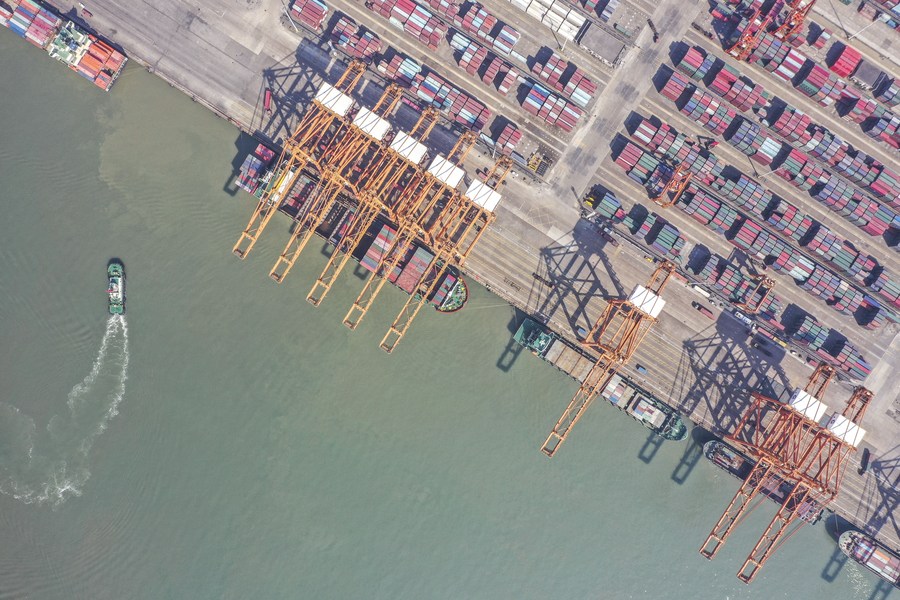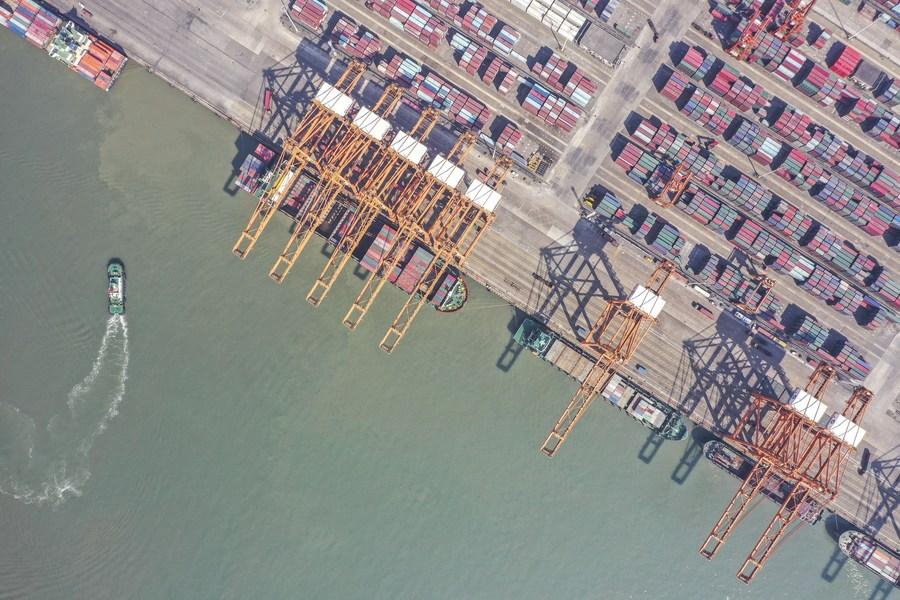
Aerial photo taken on Jan. 14, 2021 shows a view of the container wharf of Qinzhou Port, south China's Guangxi Zhuang Autonomous Region. (Xinhua/Cao Yiming)
BEIJING, June 1 (Xinhua) -- Amid the raging COVID-19 pandemic and other complex and grim situations, the construction of the New International Land-Sea Trade Corridor has been expedited in an all-round way, helping accelerate the building of the new development paradigm of "dual circulation" that allows the domestic and overseas markets to reinforce each other with the domestic market as the mainstay, strengthen economic and trade cooperation between China and the Association of Southeast Asian Nations (ASEAN), and maintain the stability of global supply chains.
On May 21, a China-Laos Railway freight train set off smoothly from south China's Chongqing Municipality and arrived in Laos' capital Vientiane after four days. It has become the first China-Laos Railway freight train along the New International Land-Sea Trade Corridor that left China using the mode of "rapid railway entry and exit customs clearance" which has helped effectively shorten the overall running time.
This is one of the latest developments in the construction of the New International Land-Sea Trade Corridor.
-- Fully accelerated construction
The New International Land-Sea Trade Corridor is a trade and logistics passage jointly built by provincial-level regions of western China and ASEAN countries. With Chongqing as its operations center, the corridor uses railway, seas and highways to link ASEAN countries by coastal or border ports in Guangxi Zhuang Autonomous Region and Yunnan Province to the south. The logistics time is significantly shorter than the traditional east-to-sea-channel.
In August 2019 and September 2021, the National Development and Reform Commission (NDRC) issued the overall planning for the New International Land-Sea Trade Corridor and the implementation plan on promoting the high-quality construction of the corridor during the 14th Five-Year Plan period.
At the national level, an inter-provincial joint conference led by NDRC has been established, and the 12 provincial-level regions in western China have established a "13 plus 1" cooperation mechanism with Hainan Province and Zhanjiang City of Guangdong Province to promote the overall acceleration of the corridor construction.
"In 2017 when the corridor opened, there was only one route, but now there are three main routes in the east, middle and west. The operating routes are rapidly expanding and a dense logistics network is taking shape," said Liu Wei, director of the logistics and operation organization center of the corridor.
For example, in 2021, the first China-Laos Railway international freight train service (Chengdu-Vientiane) was launched along the New International Land-Sea Trade Corridor. Data showed that by the end of 2021, the logistics network of the corridor has expanded from 58 ports in 35 countries and regions in 2020 to 315 ports in 107 countries and regions.
The logistics scale of the corridor has also achieved rapid growth. Taking the rail-sea combined freight train service opened in Chongqing as an example, from 2017 to 2021, trips made by such trains registered 48, 609, 923, 1,297 and 2,059, respectively.
"Especially since the outbreak of the epidemic, the three logistics forms of the New International Land-Sea Trade Corridor have all bucked the trend and grown," said Hu Hongbing, deputy director of the port logistics office of the Chongqing Municipal People's Government.
Hu added that in 2021, along the corridor, 6,117 trips were made by the rail-sea combined freight trains in the western region, up 33 percent year on year, 3,347 trips were made by cross-border highway shuttle buses, up 19 percent year on year, and 1,904 trips were made by the China-Vietnam international railway combined freight trains, up 50.6 percent year on year.
The operation quality of the corridor is also steadily improving. At the beginning of its opening, many return trips made by the freight trains along the corridor carried no goods, and only more than 50 kinds of goods were transported. Now, the two-way transportation balance has been achieved. In 2021, the goods transported out and back was 54:46 in volume and 51:49 in value, with the categories increasing to more than 640.
In addition, provinces, autonomous regions and municipalities along the corridor have deepened reform and innovation in port clearance, reducing the overall clearance time by more than 60 percent from 2017.
-- Helping promote the building of the new development pattern and stabilize global supply chains
At the beginning of this year, a batch of wolfberry raw pulp produced in northwest China's Ningxia Hui Autonomous Region was carried by the rail-sea combined freight train along the New International Land-Sea Trade Corridor for the first time, and exported to Canada by sea after passing through the Qinzhou port in Guangxi, with the logistics time saved by more than 30 days compared with the traditional river-sea combined transport line.
"By cooperating with New Land-Sea Corridor Operation Co., Ltd., we have developed wolfberry pulp and wine, registered the trademark of 'Luhaiyoupin (land-sea excellent products)', and successfully exported them via the corridor", said an official from the Department of Commerce of Ningxia.
Against the complex and severe economic situations at home and abroad, the New International Land-Sea Trade Corridor has helped drive the development and opening up of the western region.
It is learned that the corridor has become the most convenient access to the sea in the western region with geographical disadvantage. Thanks to the corridor, various featured products in the region have entered the international market, including the wolfberry pulp and wine in Ningxia, the nuts in Xinjiang Uygur Autonomous Region, the mineral water in Chongqing, the tea in Guizhou Province, etc.
In addition, the provinces, autonomous regions and municipalities in the western region have also achieved coordinated development by leveraging the corridor. For example, the coal from Inner Mongolia Autonomous Region and Shaanxi Province can be transported to Chongqing and other places through the corridor to alleviate local coal shortages; the sodium carbonate from Qinghai Province can be transported to Guangxi via the corridor to support its glass industry; the glass from Guangxi can be transported to Sichuan Province and Chongqing through the corridor to support the automobile industry, according to Wang Yupei, chairman of New Land-Sea Corridor Operation Co., Ltd.
The New International Land-Sea Trade Corridor has also become a lever that drives the transfer of industries from the east to the west. In the Qinzhou Port of Guangxi, the Huayi Qinzhou chemical & new material integration base project is under construction. Liu Xunfeng, chairman of Shanghai Huayi (Group) Company, said that settling in Qinzhou could not only enjoy the lower factor costs in western China, but also exploit the international market by taking advantage of the New International Land-Sea Trade Corridor.
The New International Land-Sea Trade Corridor has helped boost economic and trade exchanges between China and ASEAN and contributed to the building of China-ASEAN comprehensive strategic partnership.
With the support of the corridor, featured products in Southeast Asia, such as glutinous rice from Thailand, durian from Malaysia, and bananas from Cambodia, can enter the Chinese market faster.
Meanwhile, relying on the corridor, China is exploring the project of "China-Cambodia banana industrial park" with Cambodia to build an integrated banana supply chain of transportation, trade and production, and promoting the formation of a Malaysian supply chain resource center targeting palm oil, rubber, petroleum and other resources in Malaysia.
"The Chinese market is very important to us. After the opening of the China-Laos Railway, Thai glutinous rice has entered the Chinese market through the New International Land-Sea Trade Corridor for the first time and faster," said Mongkol Visitstump, Thai Consul General in Kunming of Yunnan, in an interview, adding that the New International Land-Sea Trade Corridor has enabled Southeast Asian countries to get more deeply involved in the Belt and Road Initiative and thus win more development opportunities.
The New International Land-Sea Trade Corridor drives the opening-up and development of the western region, helping form a high-quality internal circulation system, and connects the Silk Road Economic Belt and the 21st Century Maritime Silk Road, said Li Jing, vice president of Chongqing Technology and Business University, adding that it will help China form the new development pattern and meanwhile maintain the stability of global supply chains.
(Edited by Gu Shanshan with Xinhua Silk Road, gushanshan.1987@163.com)




 A single purchase
A single purchase









